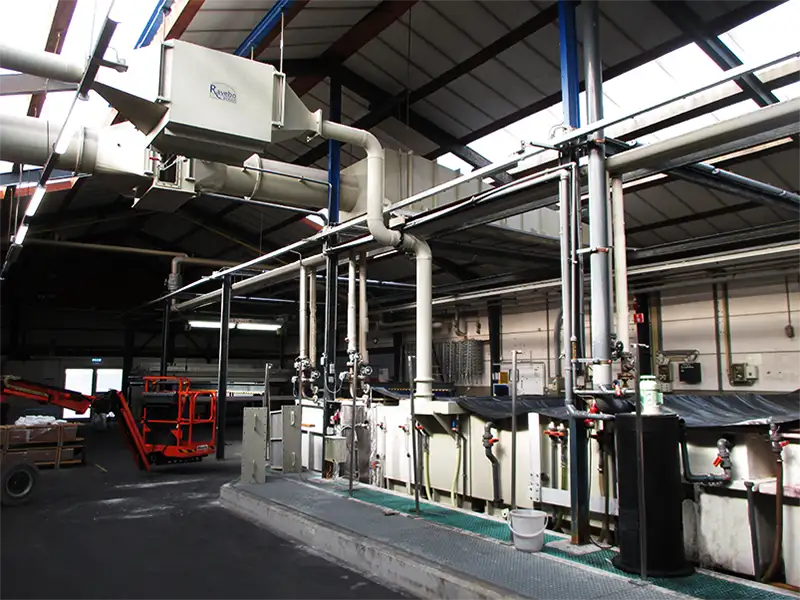Gas Scrubbers for Electroplating Technology and Surface Treatment
 Electroplating is a commonly used electrochemical surface treatment for corrosion-sensitive metals. With this process, an additional corrosion-resistant metal layer is applied electrically in order to maintain the mechanical properties for a longer period of time. Electroplating ensures, among other things, better resistance to corrosion, better protection against damage and scratches, and a better appearance of constructions or machines, such as in chrome plating. The most common electroplating techniques are anodizing, electrolytic nickel plating, and electrolytic galvanizing.
Electroplating is a commonly used electrochemical surface treatment for corrosion-sensitive metals. With this process, an additional corrosion-resistant metal layer is applied electrically in order to maintain the mechanical properties for a longer period of time. Electroplating ensures, among other things, better resistance to corrosion, better protection against damage and scratches, and a better appearance of constructions or machines, such as in chrome plating. The most common electroplating techniques are anodizing, electrolytic nickel plating, and electrolytic galvanizing.
Liquid baths
Most of the electroplating processes use a liquid bath, usually an aqueous solution of salts, acids, alkalines, or combinations of chemicals. The composition of the bath liquid depends on the material to be applied and the specific embodiment. These liquid baths can be a major burden on the environment and are therefore subject to extremely strict rules.
Released emissions
Emissions occur during electroplating, which depend on the bath composition, type of electrolyte (acidic, basic, or containing cyanide), temperature of the bath, and the volatility (vapor pressure) of the components used. Common emissions from liquid baths are acid vapors (chromic acid, nitrous vapors, hydrogen fluoride, hydrochloric, and sulfuric acid), metals (cadmium, chromium, copper, lead, nickel, tin, silver, and zinc), (hydrogen) cyanides, and ammonia.
Reduce and capture emissions
The emissions from a galvanization line, which include substances like sulfuric acid, nitric acid, hydrochloric acid, formic acid, acetic acid, propionic acid, and hydrogen fluoride, etc., must be captured for environmental protection. To this end, Ravebo designs, supplies, and installs scrubbers that can clean these waste gases in a simple but effective way.
How the scrubber works
The principle of the scrubber is largely based on neutralizing the acidic vapors by means of sodium hydroxide (NaOH) dissolved in water. This washing water is continuously pumped around where the sodium hydroxide reacts with the acid to achieve an absorption rate >95%. The washing water level is monitored, and replenishment water is supplied from a downstream neutral washing stage to offset evaporation and discharge losses. The pH value is maintained using a NaOH dosing system.
The neutral Wash section
In principle, only water is pumped around in the downstream neutral washing section to absorb any entrained components. Here, there is no more evaporation of water, and only the evaporation loss of the NaOH washing ladder is compensated. The quality of the washing water is checked using a conductivity sensor.
Scrubber made to measure
Scrubbers are typically constructed from polypropylene for indoor installations or polyethylene for outdoor installations due to their corrosion resistance, ease of processing, and competitive price-to-quality ratio. The scrubbers are available in horizontal and vertical versions and can be made up of one or more sections.
